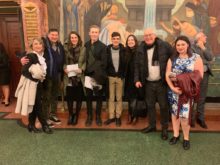At eleven-thirty on a Friday night in December, I found myself reclined on a beanbag in the midst of the world-famous Budapest Festival Orchestra’s viola section. I was there with several hundred young Hungarians for a special concert in which audience members are invited to sit on multicoloured beanbags dispersed among the orchestra for a unique and intimate performance experience. As the orchestra played movements from Berlioz’s Symphonie Fantastique, I watched the faces of the concertgoers around me. Some closed their eyes, some smiled, and some watched the musicians with intense focus. At one in the morning, as I headed back to my hostel across Budapest’s iconic Chain Bridge, I felt energized and inspired. I had never been to an orchestra concert that attempted to create such a close connection with its young audience. The concert felt like a direct rebuttal to those who despair over millennials’ lack of culture and obsession with technology.
I was in Hungary as part of a research trip with Professor Robert Austin and five of my classmates at the Centre for European, Russian, and Eurasian Studies (CERES) with the goal of conducting interviews for individual research projects about issues in contemporary Hungary. I was investigating Hungarian arts funding and how cultural policy has changed in the past decade under Prime Minister Viktor Orbán. The other students were exploring Holocaust memory discourse, anti-immigration narratives, the history of Hungarian LGBTQ activism, recent attacks on the Hungarian constitution, and the institutionalization of the Roma experience in Hungary. During the week in Budapest, we conducted interviews with Hungarians involved in our research areas. For my project, I spoke with people from across the cultural sector, ranging from those who worked at small, independent theatres and galleries to the director of the Hungarian State Opera, a government employee, as well as arts critics and administrators.
A few days before the memorable beanbag concert, I had witnessed thousands of Hungarians in downtown Budapest protesting a proposed new law that would increase the government’s control over certain areas of arts and culture. In particular, the law would target the artistic freedom of independent theatres and restructure the main cultural funding organization. Though my limited Hungarian prevented me from understanding the demonstrators’ speeches, anger and urgency were evident in their voices, and the crowd, I learned, was chanting, “Culture is the foundation of a nation.” While the mood of the demonstration was vastly different from my joyful experience at the late-night concert, I was moved by the passion for arts and culture that I saw around me. It was a complete coincidence that the demonstration happened during my visit, and it lent an extra feeling of relevance to my project.
The trip to Hungary occurred at the end of a very busy semester, but any tiredness disappeared the moment I began my interviews. It was incredibly invigorating to learn in such an interactive and hands-on manner. Suddenly, I could draw clear connections between what I had read in my research and how it influenced the lives of real people. My classmates had similar experiences, and I loved hearing about their interviews when we reconvened at meals or in our hostel.
Our trip was made possible by the extreme generosity of Tom and Irene Mihalik, who joined us in Budapest. We are incredibly grateful to them for providing us such a special opportunity. We also want to thank Professor Austin for his guidance, encouragement, and unlimited positivity and enthusiasm. He arranged many interesting activities for us during the week including visits to the Parliament and National Gallery, a concert at the Ferenc Liszt Academy, and a meeting with Central European University’s President and Rector Michael Ignatieff.
The trip to Budapest was by far the highlight of my first semester at CERES and one of the most educational and stimulating weeks of my life. There is no better way to learn than to be completely immersed in a new culture. It was also fun to get to know my fellow students and explore the city together. I was already a fan of Hungarian cuisine, and getting to eat chicken paprikash multiple times in one week was – and remains – my true idea of heaven.
In the next couple months, my classmates and I will each write a paper based on the research we conducted in Budapest. It will be interesting to condense my pages of notes into something concrete as I reflect upon all that I experienced and observed. The trip to Budapest allowed us to have a truly interdisciplinary experience; by immersing ourselves fully in our surroundings, we were able to gain a much more complex and nuanced understanding of our projects and of Hungary itself.
by Catherine Lukits, CERES MA candidate
